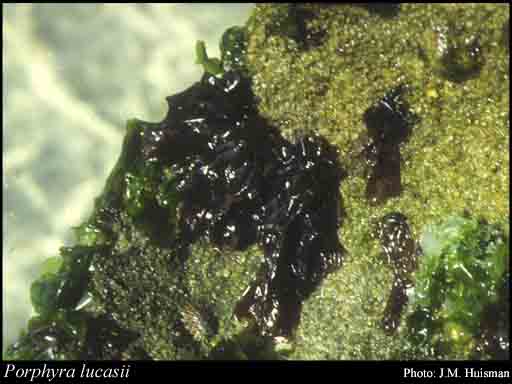- Reference
- Ark.Bot. 469-471, Figs 6H-L, 7 (1953)
- Conservation Code
- Not threatened
- Naturalised Status
- Native to Western Australia
- Name Status
- Current

Scientific Description
Habit and structure. Thallus red to purple, (2–)5–20(–40) cm long and 1–10(–15) cm broad, relatively delicate, lanceolate to broadly ovate or cordate, simple or irregularly laciniate or basally branched, sometimes umbilicate by basal proliferation, margin smooth to undulate (rarely denticulate), blades monostromatic, 20–30 µm thick, attached by a rhizoidal holdfast; epilithic or on solid substrates. Growth diffuse. Cells mostly irregularly arranged, more or less isodiametric, (6–)8–15 µm across, separated by a gelatinous matrix 0.5–1 times the cell width; rhodoplasts single, axial, each with a pyrenoid. Sporophyte (conchocelis phase) unknown.
Reproduction. Monospores formed in patches near the thallus margins. Carposporangia apparently developing later than spermatangia, not prominent, covering areas between the spermatangial strips near the thallus margin, without intermingled vegetative cells, with about 8 carposporangia per group. Spermatangia occurring in well-marked elongate strips extending in from the apical and side margins of the thallus, 2–20 mm long and 1–5 mm broad, in packets of 16–32, spermatia 3–4 µm in diameter.
Distribution. Trigg, W. Aust., to Westernport Bay, Vic., and the north and east coasts of Tas.
Habitat. P. lucasii usually grows on rock in the mid eulittoral of calm to moderately rough-waters; it is essentially a winter species.
[After Womersley, Mar. Benthic Fl. Southern Australia IIIA: 39–41 (1994)]
Distribution
- IBRA Regions
- Swan Coastal Plain.
- IBRA Subregions
- Perth.
- IMCRA Regions
- Central West Coast, Leeuwin-Naturaliste, WA South Coast.
- Local Government Areas (LGAs)
- Albany, Capel, Cottesloe, Rockingham, Wanneroo.